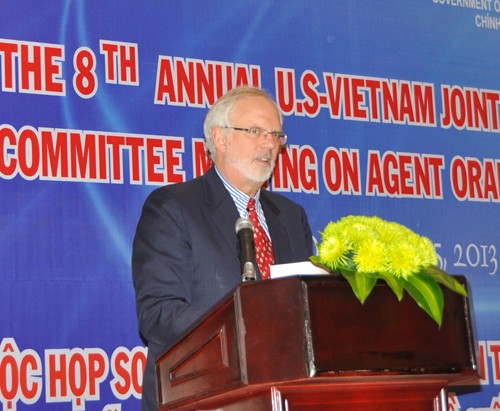
For Immediate Release
DANANG, December 4, 2013 -- On December 4-5, 2013, the United States hosted the eighth meeting of the U.S-Vietnam Joint Advisory Committee (JAC) on Agent Orange/Dioxin in Danang. This two-day meeting allowed Vietnamese and U.S. scientific experts to exchange views and expand dialogue on issues related to Agent Orange/dioxin. The JAC has met annually since 2006 to provide scientific advice to the governments of Vietnam and the United States on dioxin contamination cleanup and research on health issues associated with dioxin.
“This event serves as a reminder of the level of cooperation and trust that exists between our two countries, and comes only months after President Sang and President Obama signed the U.S.-Vietnam Comprehensive Partnership at the White House,” said U.S. Ambassador to Vietnam David B. Shear at the opening ceremony. “Both of our Presidents agreed that extensive cooperation in addressing war legacy issues has allowed us to develop a relationship that looks to the future. Today we come together again to advance this forward-looking relationship and work toward our shared goal of overcoming the legacy of Agent Orange.”
At the meeting, the U.S. Agency for International Development (USAID) and the Ministry of National Defense (MND) highlighted the progress with the Agent Orange/Dioxin Cleanup Project at Danang airport, considered to be a dioxin “hotspot” due to the high dioxin concentrations in soil and sediment. Since the project launched in August 2012, U.S. and Vietnamese government partners have filled a newly-constructed containment structure with 45,000 cubic meters of dioxin-contaminated soil. This soil will be heated to 335°C in the coming months to destroy the dioxins present. The project is on track to clean up all dioxin contamination in the area by the end of 2016 and consequently eliminate risk of dioxin exposure to the surrounding community.
During the meeting, MND presented their Master Plan for Remediation of Bien Hoa Airbase, which is considered to be another dioxin “hotspot.” Participants also reviewed the results of a recent workshop organized by the Ministry of Natural Resources and Environment (MONRE) on lessons learned in dioxin pollution assessments and remediation in Vietnam.
The JAC is composed of scientists and officials from MONRE, MND, the Ministry of Foreign Affairs, the Ministry of Health, Vietnam Academy of Science and Technology from Vietnam and the U.S. Centers for Disease Control and Prevention (CDC), Environmental Protection Agency (EPA), Department of Defense, Department of State, and USAID from the United States. The JAC meeting was co-chaired by Dr. Le Ke Son, Director General of the Office of National Steering Committee 33, MONRE, and Dr. Tom Sinks, Deputy Director, National Center for Environmental Health, CDC.







Comment
Make a general inquiry or suggest an improvement.